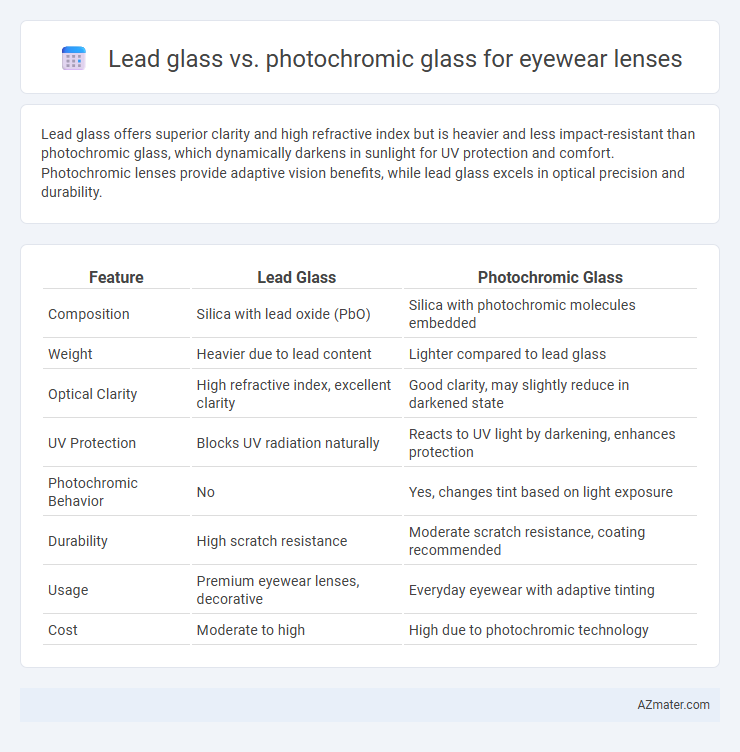Lead glass offers superior clarity and high refractive index but is heavier and less impact-resistant than photochromic glass, which dynamically darkens in sunlight for UV protection and comfort. Photochromic lenses provide adaptive vision benefits, while lead glass excels in optical precision and durability.
Table of Comparison
| Feature | Lead Glass | Photochromic Glass |
|---|---|---|
| Composition | Silica with lead oxide (PbO) | Silica with photochromic molecules embedded |
| Weight | Heavier due to lead content | Lighter compared to lead glass |
| Optical Clarity | High refractive index, excellent clarity | Good clarity, may slightly reduce in darkened state |
| UV Protection | Blocks UV radiation naturally | Reacts to UV light by darkening, enhances protection |
| Photochromic Behavior | No | Yes, changes tint based on light exposure |
| Durability | High scratch resistance | Moderate scratch resistance, coating recommended |
| Usage | Premium eyewear lenses, decorative | Everyday eyewear with adaptive tinting |
| Cost | Moderate to high | High due to photochromic technology |
Introduction to Lead Glass and Photochromic Glass
Lead glass, known for its high refractive index and excellent clarity, is primarily used in optical lenses to enhance light transmission and reduce chromatic aberration. Photochromic glass contains molecules that react to ultraviolet light, darkening when exposed to sunlight and returning to a clear state indoors, providing adaptive vision protection. Both materials serve distinct purposes in eyewear, with lead glass offering superior optical quality and photochromic glass delivering dynamic light sensitivity for user comfort.
Composition and Manufacturing Differences
Lead glass lenses contain high levels of lead oxide, which increases their refractive index and density, resulting in enhanced clarity and weight. Photochromic glass lenses incorporate organic photochromic dyes embedded within the glass matrix, enabling them to darken upon UV exposure and revert to clear indoors. Manufacturing lead glass involves melting and refining lead oxide with silica and other additives, while photochromic lenses require precise integration of light-sensitive compounds during the glass melting or coating processes to ensure responsive tint changes.
Optical Clarity and Light Transmission
Lead glass lenses offer superior optical clarity with high refractive indices, providing sharp vision but tend to have higher weight and limited light transmission control. Photochromic glass lenses dynamically adjust light transmission by darkening in response to UV exposure, enhancing comfort in varying light conditions without compromising clarity. Both materials balance optical clarity and light transmission differently, with lead glass excelling in crisp vision and photochromic glass providing adaptive light modulation.
UV Protection Capabilities
Lead glass lenses offer minimal UV protection as their primary function is weight and refractive index enhancement rather than filtering ultraviolet rays. Photochromic glass lenses provide superior UV protection by automatically darkening upon exposure to UV light, effectively blocking 100% of UVA and UVB rays. Choosing photochromic lenses ensures optimal eye safety from harmful ultraviolet radiation during both indoor and outdoor activities.
Weight and Comfort in Everyday Wear
Lead glass lenses, known for their high density and durability, tend to be heavier, which may cause discomfort during prolonged everyday wear. Photochromic lenses, often made from lightweight materials like polycarbonate or high-index plastic, offer superior comfort by reducing overall lens weight while adapting to light changes. For daily use, photochromic lenses provide a balance of comfort and functionality, making them preferable for those prioritizing lightweight eyewear.
Durability and Scratch Resistance
Lead glass lenses are known for their high density and clarity but tend to be more brittle, making them less durable and more prone to scratches compared to photochromic lenses. Photochromic glass incorporates specialized coatings and materials that enhance scratch resistance while maintaining durability through adaptive light absorption. Consumers seeking eyewear with superior longevity and minimal surface damage often prefer photochromic lenses over traditional lead glass options.
Performance in Varying Light Conditions
Photochromic glass lenses adapt dynamically to changing light conditions by darkening in bright sunlight and clearing indoors, offering optimal vision and UV protection across environments. Lead glass lenses provide high optical clarity and weight, but lack the adaptive tinting properties necessary for fluctuating light, potentially causing discomfort or eye strain. Photochromic lenses outperform lead glass in versatility and performance, ensuring consistent visual comfort from low indoor lighting to intense outdoor glare.
Safety Concerns and Health Implications
Lead glass lenses contain lead oxide, raising concerns about potential lead exposure, particularly if the lens is damaged or improperly handled, whereas photochromic lenses use organic compounds to darken in response to UV light without harmful chemical risks. Photochromic glass provides dynamic light adaptation, reducing eye strain and UV damage, while lead glass offers limited protection but can pose toxicity hazards if fragments are ingested or come into prolonged skin contact. Both materials require careful consideration for health and safety, with photochromic lenses generally preferred for everyday eyewear due to their non-toxic composition and enhanced UV protection.
Cost Comparison and Availability
Lead glass lenses tend to be more expensive due to their high density and specialized manufacturing process, limiting their availability primarily to niche markets. Photochromic glass lenses offer moderate pricing with widespread availability, benefiting from mass production and increasing consumer demand for adaptive eyewear. Consumers seeking cost-effective options often find photochromic lenses more accessible than the pricier lead glass alternatives.
Choosing the Right Glass for Your Eyewear Needs
Lead glass offers exceptional radiation shielding and high refractive index, making it ideal for protective eyewear in medical or industrial settings. Photochromic glass adjusts its tint based on light exposure, providing convenience and UV protection for everyday wear. Selecting the right lens depends on prioritizing either enhanced safety features or dynamic light adaptation for optimal visual comfort.

Infographic: Lead glass vs Photochromic glass for Eyewear lens
 azmater.com
azmater.com